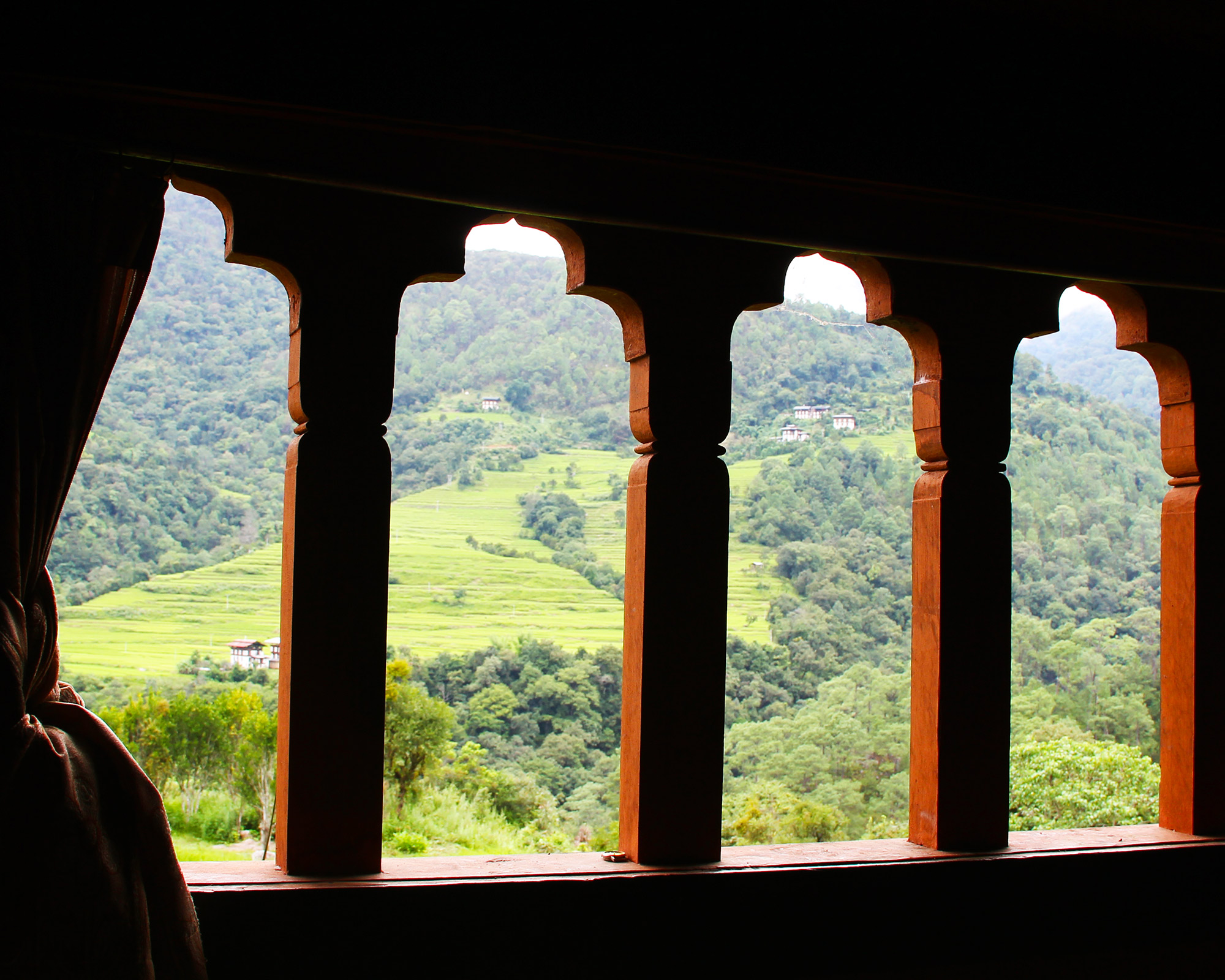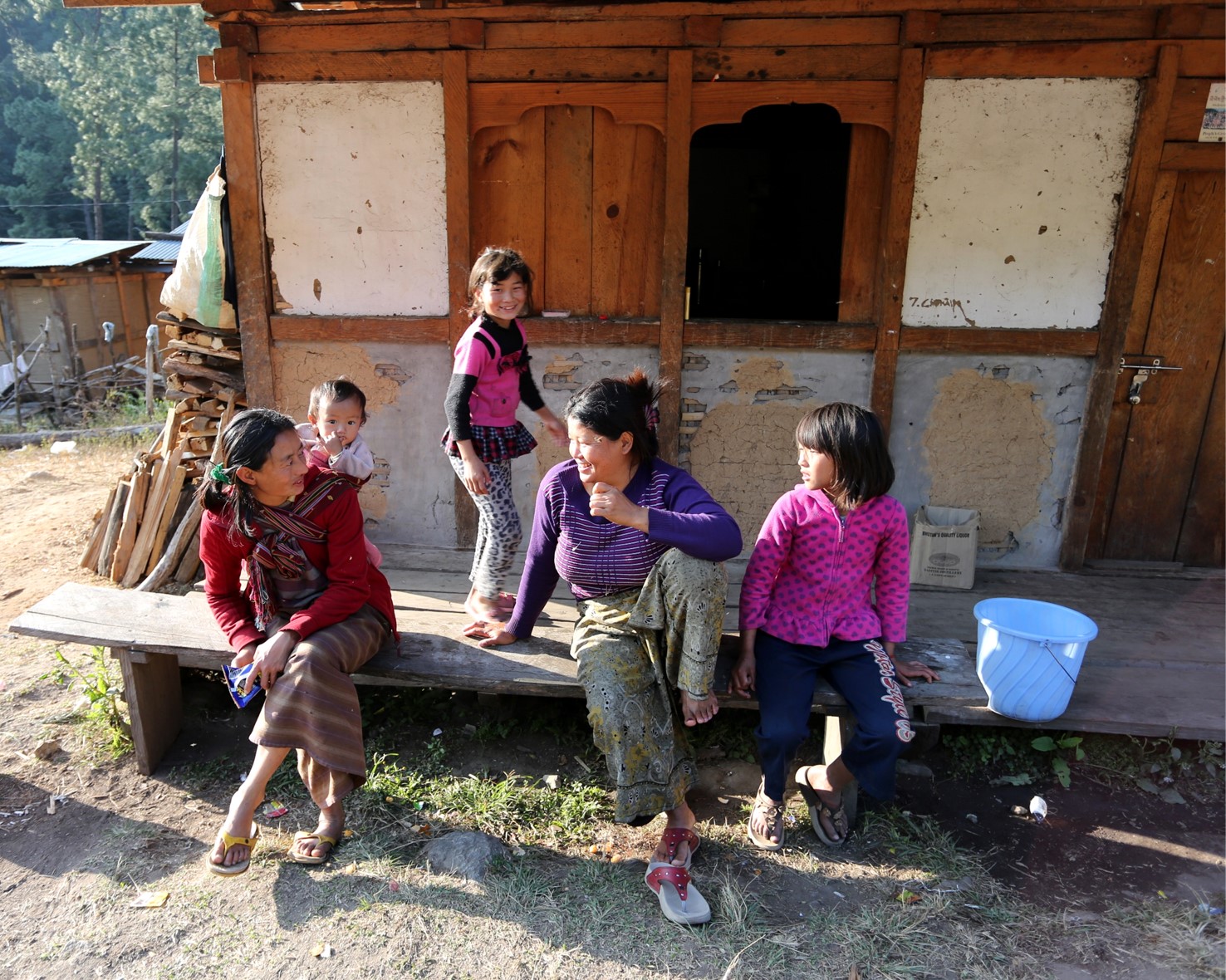Home is Where The Heart Is

Ugyen and I sit cross legged by a window in his family home, looking out onto the PunakhaPunakha (Dzongkha: སྤུ་ན་ཁ་) is the administrative centre of Punakha dzongkhag, one of the 20 districts of Bhutan. Punakha was the capital of Bhutan and the seat of government until 1955, when the capital was moved to Thimphu. https://en.wikipedia.org/wiki/Punakha valley. Day breaks early here, the mist in the valley suspended halfway up the mountain. The first rays from the sun cresting the hill light up the slopes facing the house, the lush temperate forest an intricate embroidered coat over the looming mountain form. The light picks out the roofs of a few houses glistening like jewels in the green, and the steeple of a temple and rows of prayer flags allow us to trace unseen footpaths in our mind’s eye.
Over steaming hot cups of sujaSuja or Butter tea is a staple drink of the people in the Himalayan countries such as Nepal, India (in particular Sikkim and Ladakh), Tibet and Bhutan. Read More., Ugyen speaks of his life growing up here, a ten minute walk from the village of Thangbji. The pace of life has changed little in these parts, and that unchanging existence is reflected in the view, one that has been the same as long as he can remember. As he bursts into his signature booming laugh, he jokes that anyone looking at his house might think the same of him!

Ugyen relates the tale of how his father came to possess this land, “Chaana”. After some time in the military, Ugyen’s father was appointed an attendant to the third king’s brother, whom he served for many years. When it was time for him to retire, he was offered compensation for his service. “And all he asked for”, Ugyen exclaims, “was a radio!” It was only through the generosity of the queen mother that he was granted this land and the aid of people to build a home. Narrating this story today, Ugyen rues his father’s lack of foresight, believing he could have created better opportunities for his children by placing greater value on his labour.
Ugyen is of the generation that has seen the most dramatic changes in the country. They have watched Bhutan move from a primarily tribal and monarchist culture to a more “modern” society. The shift in social and cultural values accompanying this transition is reflected in the architecture. The gulf between the old and the new is evident in the ways that the cities are developing and the way that new construction and design is approached. Most adults have left their villages behind, finding little scope for their futures in a rural environment. There is still, however, a very strong tie they feel to their hometowns – the community spirit which seems lacking in the cities they now call home. Ugyen’s journey, too, has led him from his village to his current life in Thimphu.

Village life is about sharing resources to survive. Members of the community come together to plant and harvest in the fields and to celebrate annual festivals. Building of a house is initiated by the individual, but supported by the entire village. Spaces of congregation are informal and organic, scaled to accommodate the smaller numbers characteristic of village populations. Resources are bartered or obtained from the surrounding forests, people living in symbiosis with their surroundings. This inter-dependency forms strong communities which take precedence over the individual, balancing the use of resources and creating a sense of security and belonging.
One observes the fragility of these systems in the face of larger changes in Bhutan. While technological progress and modern conveniences are necessary, they change the fabric of rural life and make it harder for villages to stay relevant. Old ways of living are no longer sufficient to support modern lifestyles. Ugyen returns periodically to his roots to refresh his soul, each time struck by his sense of belonging but knowing he cannot stay for good. He believes that the resistance and skepticism with which new ideas and innovation are met are the greatest obstacles to making villages sustainable today.

Historical processes and practices are often collateral damage in the rush towards development. They are often merely imitated, and sometimes entirely forgotten, rather than adapted to the current context. Ugyen contrasts his life now with his experiences of childhood and youth – recalling the various places and spaces he has inhabited and visited, and the spirit of community within them. He is bemused at the fact that the same people who grew up in these spaces become indifferent individuals when they move away – “Why can’t we take this sense of community to the city?”
This section follows Ugyen through those spaces, understanding their roots in history and community, and exploring how those connections have changed with time.
Vignettes






It is true that villages or rural life as we call it does come with lack of initiative,openness. I have lived some part of my childhood in rural Kerala. And all I could remember thinking was when will I ever get to live in a town. So wishing away towns or cities is not correct. It is really important to marry the best of both the world’s for times ahead
The purpose you had set for this – going under the ‘shangrilla’ like beauty of Bhutan and unravelling many layers with lens of architecture , beauty, rural and urban dynamics and its implications on rural folks is a journey akin to that of a pilgrim. i am waiting with bated breath for the next in series!
Great and beautiful work of passion and heart! Hats off to you!